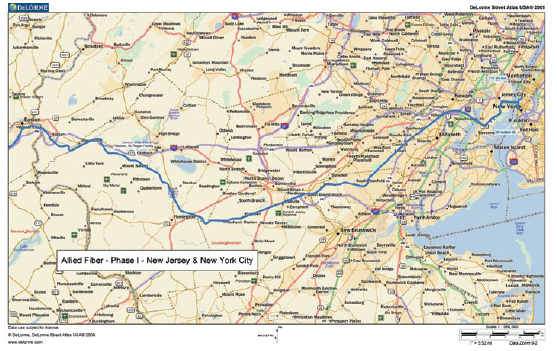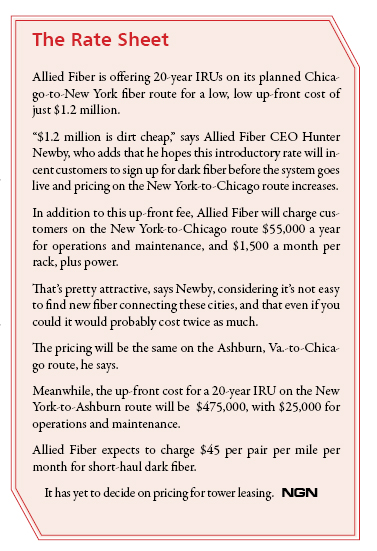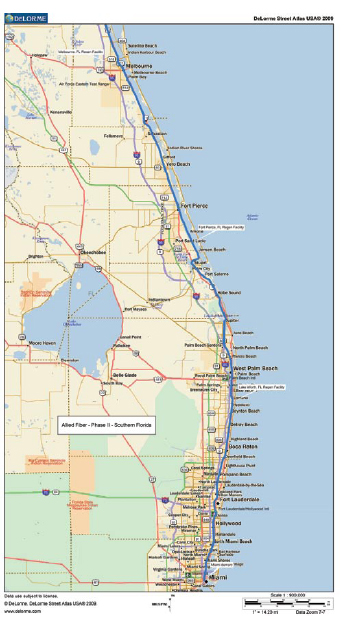Allied Fiber to Launch Nationwide Fiber Network to Fill Market Void

By Paula Bernier
Hunter Newby (News - Alert), co-founder of Telx, is building a nationwide dark fiber network that promises to bring more affordable and efficient transport to a wide variety of customers. The new venture, called Allied Fiber, and Telx (which Newby and the team sold in October 2006), are two very different businesses. But Newby indicates that both have moved to address important needs in the market.
Prior to "meet me" rooms, which Newby established while at Telx, it took months to interconnect, and carrier hotel tenants frequently had to pull ceiling tiles and break through brick walls to interface with one another. Creating a single process and location
within a carrier hotel through which tenants could easily interconnect was an innovation that has saved many carriers a lot of time, money and hassle.
"We brought order to the chaos," he explains.
That’s exactly what CEO Newby – along with Allied Fiber’s President and COO Jason Cohen (News - Alert) and Vice President of Engineering
and Construction Patrick Opelt – plan to do again with Allied Fiber.
The New York-based company will sell dark fiber – as well as space in collocation buildings and on towers along the route – starting
in late summer or early fall. That’s welcome news to many network operators
that have come up dry when searching for dark fiber within the U.S., says Newby.

The Void
The wholesale operations of incumbent
LECs, as well as competitive providers like Level 3 Communications (News - Alert),
offer lit fiber, he explains, but these carriers aren’t interested in selling
dark fiber either because it is in limited supply within their networks, they don’t want to cannibalize their lit fiber business, or both.
"Level 3 went off to acquire Progress and Broadwing (News - Alert) and WilTel, who were all competitive transport networks, and they are what kept balance
in the country in terms of access and transport. Well, guess what? They’re gone. And now what do we have?" asks Newby.
"I know of dozens of carriers that … are in desperate need of their own fiber so they can control the underlying economics, and they can be viable," he adds.
As a result, Allied Fiber has set out to blow fiber through ducts along various railroad rights-of-way across the country.
The Network
The first phase of the build will involve the installation of parallel short- and long-haul fiber networks from New York to Chicago and then down to Ashburn, Va., through Harrisburg, Pa.
This initial 1,300-mile network will follow the railroad tracks owned by Norfolk Southern Corp., with which Allied Fiber has dirt rights-of-way leases for 25 years, with two five-year renewal options. However,
Norfolk Southern already has duct installed along about 80 percent
of the route involved in Allied Fiber’s first-phase build; in those cases, Newby’s company has duct lease agreements, under the same terms, with T-Cubed, Thoroughbred Technology and Telecommunications,
a Norfolk Southern subsidiary.
Between what was already in place and the new duct Allied Fiber
installed along this route, the duct part of the first phase was 97 percent complete as of April 5, when Newby last spoke with INTERNET TELEPHONY for this article. Allied Fiber had yet to jet any fiber as of that date, but the dark fiber will be installed in these ducts and ready for use starting in late summer or early fall of this year. Exactly when that happens will depend upon when Allied Fiber is able to close on its senior debt, Newby explains.
The second phase of the network, also along Norfolk Southern rights-of-way, will run from Ashburn to Roanoke, Va.; to Knoxville and Chattanooga, Tenn.; to Atlanta; and then from Jacksonville to Miami, Fla. Newby in early April said more than half of that build was ducted, but that Allied Fiber still had to build new duct in Southwest Virginia and throughout Tennessee, and to fill the duct with fiber.
“We have a ton of interest for that,” he says. “I have three different groups that want to participate in a co-build in Tennessee, which is fantastic.” Beyond that, Allied Fiber has forged relationships with a couple of railroads in expectation of a Western build. Newby has a Chicago-to-Seattle route selected and he says there’s some major demand for fiber along that path. The company also aims to put fiber on a route running from Seattle to Los Angeles and coming through Phoenix and Dallas to intercept its phase-two route.
“Most of my contacts come from the international world – undersea cable systems and international carriers,” says Newby. “Those folks just look at the U.S. as something that they need to get through; they don’t have any business here per se. They’re just looking for the shortest path, the newest glass, and the best rates and terms.”
The Spark
In fact, Newby says he decided to establish Allied Fiber after a major international carrier (likely Telefonica (
News -
Alert)) told him about the company’s need for a more affordable way to transport its traffic across the U.S. to interconnect its operations in Spain and South America.
“Because the way that networks work, Asia to Europe and Latin America largely connect to each other through the United States,” notes Newby. “That’s the way it’s been for several decades, particularly with the growth of the Internet in the ‘90s and the launch of new subsea systems in the late ‘90s and early 2000s, which all landed in the U.S. somewhere. They landed in Long Island or New Jersey or up in Washington state – the Seattle area, or California. And then those systems connected into the major carrier hotels – 60 Hudson, the NAP down in Florida and 1 Wilshire. And then, through the U.S., you have major long-haul routes that connect those buildings.”
Anyway, this major carrier, which Newby declined to name, in November of 2007 told him it needed to double its backbone capacity in one year. But to do so using lit fiber leased from a carrier in the U.S. would’ve been cost prohibitive, so the company was trying to get its hands on some dark fiber and was hoping Newby could assist it in doing so.
The Demand
“I knew this first request was what I considered to be the tip of the iceberg – if this particular carrier was having this issue in ’07 that by the same time in late ’08, or even 2009, there would be dozens of networks that were having this issue with Internet capacity issues, backbone growth and what not,” says Newby. “And I was right.”
Indeed, as of April 5, Newby says Allied Fiber had 20 customers signed on for the first phase of its build, more than 30 additional deals in process, and a handful of contracts for the phase-two effort.
Felipe J. Alvarez, president of RCN (
News -
Alert) Metro Optical Networks, in March told NGN magazine that his company is interested in what Allied Fiber is doing.

“He’s likely to have the lowest latency route for financial services,” says Alvarez of Newby, adding that the price of low-latency lit bandwidth has tripled in the last 10 months.
The Allied Fiber network will consist of a primary long-haul 432-count fiber network. A second duct on the route will contain 214-count fiber for short-haul applications. And a third duct will be dedicated to maintenance and additional space should Allied Fiber need to deploy more or different kinds of fiber in the future.
Newby says these kinds of fiber counts were unheard of when the last big fiber systems were put in place a decade ago. He adds that although people in the industry talk about advancements such as 40 and 100G waves as though they’re simply a matter of adding new network elements, the installed fiber is often 15 to 20 years old and has degraded due to weather or glass impurities, so makes performance
of these new technologies less than optimal.
The Rest
Allied Fiber also will have collocation structures about every 60 miles along its fiber routes. These huts and other buildings, at which it will lease space and offer power to its customers, will range in size from around 650 square feet to several thousand square feet, says Newby, and can be expanded as needed. These sites also will act as “meet me” rooms at which various service providers –as well as hospitals, schools, universities and anybody else with a need for interconnection – can tie in to the fiber network.

The third tenet of Allied Fiber’s plan is to offer wireless network operators and their wholesale backhaul suppliers (including Ethernet service providers and microwave outfits) space on radio towers along its fiber routes. Newby says Norfolk Southern has 4,400 towers along its rights-of-way. For phase one of its build, Allied Fiber will work to make space on 300 of those towers, which it has leased from the railroad, available to its customers.
“I’m optimistic I will be his customer,” a CEO of an Ethernet-based wireless backhaul services provider recently told NGN magazine.
Newby says Allied Fiber's strategy around wireless is completely different
from how fiber-to-the-tower typically works today. Usually, he says, companies have to build laterals from fiber rings to towers – and those laterals can be several miles away. In the Allied Fiber architecture, he continues, the fiber is never more than a few feet away from the tower.
"We can intercept the short-haul duct at that tower so we can bring fiber to the tower, but it is at an incremental cost to us," he says, adding: "This is the ‘meet me’ room model, but stretched out and incorporating cell towers."
Allied Fiber put this overall network plan together after consulting
with customers, he adds, noting that for the past several months it has been working on getting interested parties to sign letters of intent, so it has a good idea of what types of fiber they want, how much of it they want where, and what their collocation
and tower requirements are.
Newby sees Allied Fiber as being analogous to the interstate highway
system championed by President Dwight D. Eisenhower. This network, he says, will offer a standard way for carriers and other network
operators to get their traffic from one end of the country to another, or anywhere along the way, and to be able to get traffic on and off that network easily as needed.
 The Money
The Money
Allied Fiber initially had hoped to get some broadband stimulus funds from the federal government to assist it with this effort. But Newby says the company’s request for federal funds was rejected
via a curt letter during the first round of the national government’s
program. Participating in the program, he adds, was so frustrating and time consuming that he opted not to try again in the second and final round.
Instead, Allied Fiber is relying on a variety of other sources for funding.
Newby says the company has received $2.5 million from the principals
of private equity firm Corinthian Capital, at which Rory Cutaia
is executive director. Cutaia co-founded Telx with Newby, and is executive chairman at Allied Fiber. Corinthian also is supporting Allied Fiber by providing legal and other assistance.
Newby says that he hopes to accelerate things following the first two phases of the Allied Fiber build, when he expects new funding sources to open up to the company.
"It’s very difficult to cost-justify this kind of construction, which is exactly why no one else has done it," says Newby. "People who only need a pair of fibers are never going to build a whole duct system; it wouldn’t make any sense. [That’s] why we’re doing it.
"We’re building this duct system for everyone," he adds. "We’re putting
this fiber in the ground for everyone. We put in a high enough count cable so everybody can get a pair or two pair of fiber and they can run their business.
"But none of those people independently would be able to pull that off. Imagine them getting together and trying to form a consortium to do that," he concludes. "Forget it. It would be like herding cats."

NGN Magazine Table of Contents